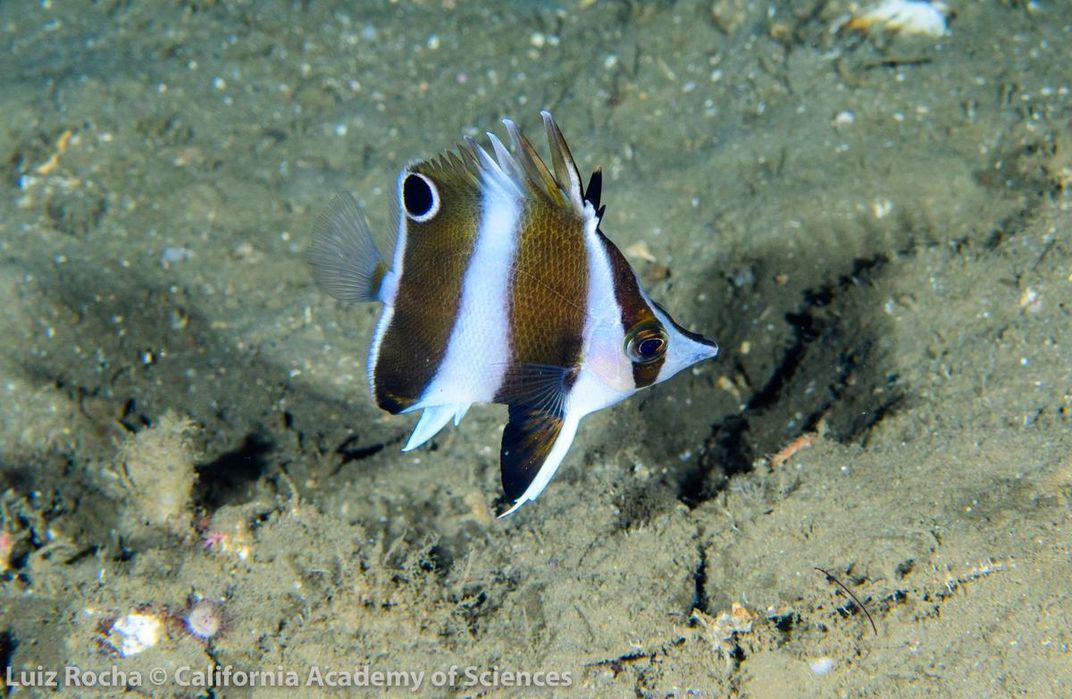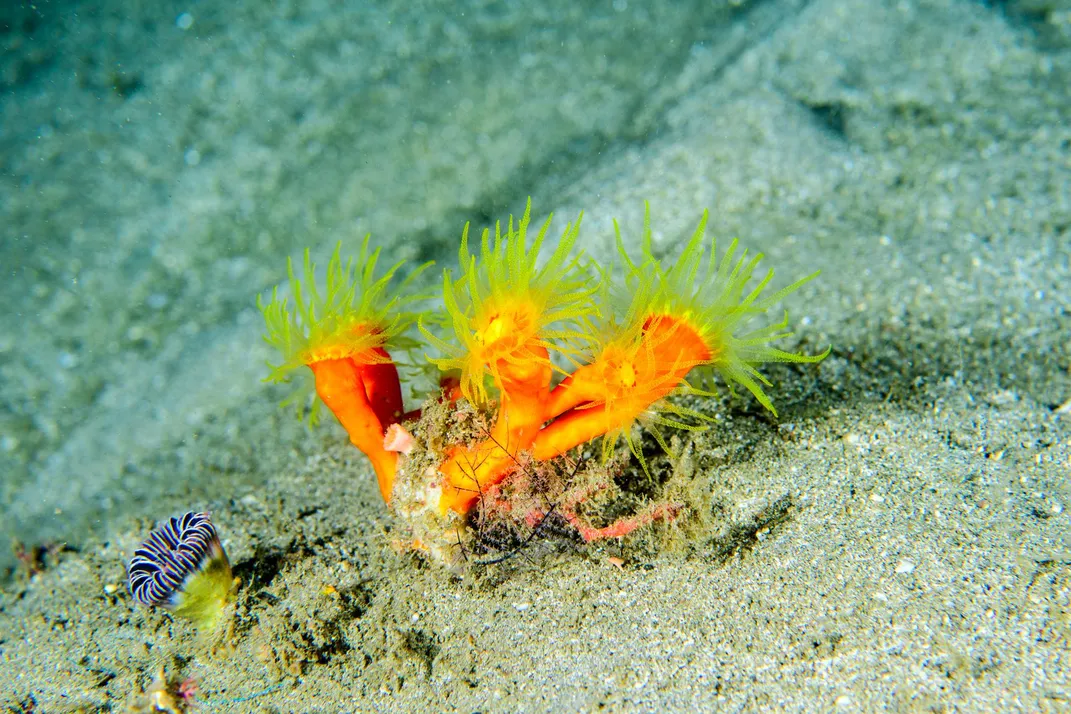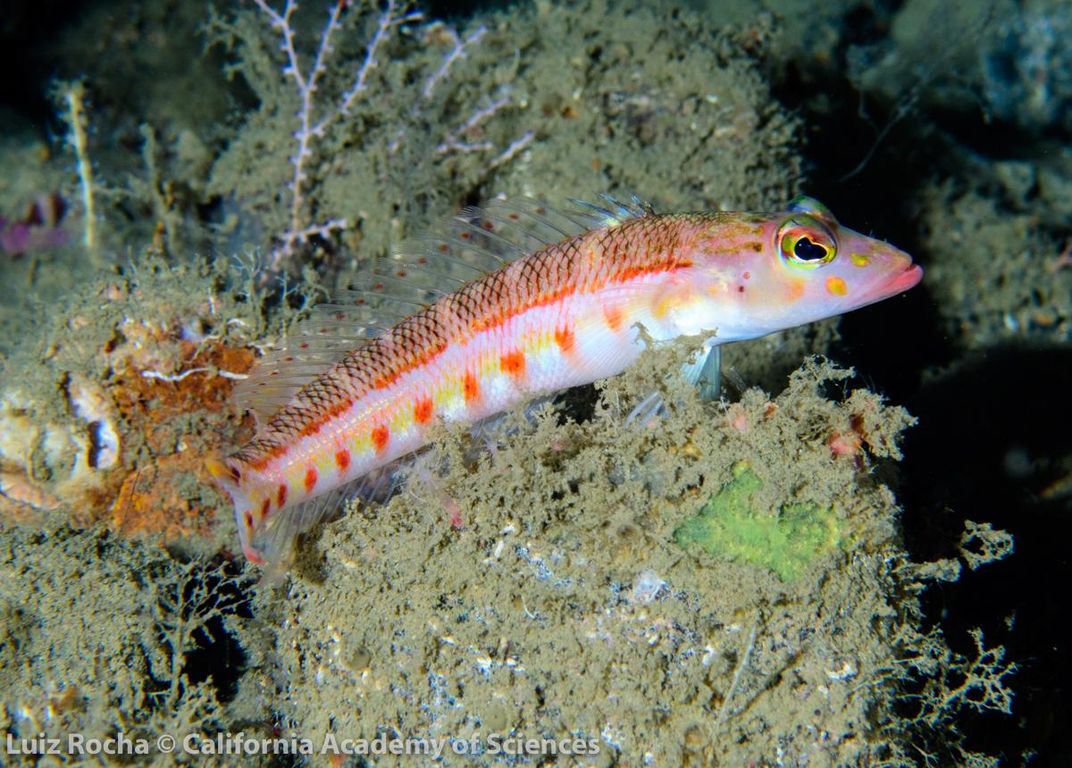Illuminating the Ocean’s Teeming Twilight Zone, Before It Disappears
Like underwater islands, these deep reefs harbor countless creatures that scientists have never heard of, and many they never will
/https://tf-cmsv2-smithsonianmag-media.s3.amazonaws.com/filer/c5/be/c5be0726-e550-4f1c-84a7-7daa54bf593b/healthy_reef_blue_acropora_and_anthias_corals_philippines_bart_shepherd__2015_california_academy_of_sciences.jpg)
One balmy morning off the island of Luzon, the largest landmass in the Philippines archipelago, I backflipped off a narrow-hulled wooden boat in scuba gear and descended into Batangas Bay. The light shaded from turquoise to pea-green as the surface receded. At 85 feet, I rendezvoused with five ascending divers, their bodies encased in mechanical carapaces of hoses and steel tanks and cameras—more than 100 pounds of gear per person. Bart Shepherd, one member of this bionic quintet, passed me a mesh sack brimming with specimens, each animal adrift within its own plastic bag like the contents of a snow globe. I peered at the animals within: vibrant orange wire corals, diaphanous comb jellies, gobies no longer than a pine needle. Some of these organisms had never been described by science.
Undiscovered species abound in the Twilight Zone, a global band of deep-water reefs that is little visited and less understood. The coral reefs that dominate the popular imagination—and the scientific literature—are shallow, sunlit gardens, accessible even to amateur divers. Sink below 130 feet or so, however, and you’ll find yourself in a dim new world. Familiar hard corals yield to technicolor soft-bodied corals that wave in the current like Seussian fever dreams. Parrotfish and rabbitfish cede to luminous basslets and goggle-eyed squirrelfish. The Twilight Zone, known to researchers as the mesophotic or “middle light” zone, is a reef deficient of plant life, a kingdom of plankton-eaters and carnivores.
“It’s awesome to drop off the side of the boat and free-fall onto a place that no one’s ever been before,” Shepherd, aquarium director at the California Academy of Sciences, told me once we'd surfaced and returned to the dive boat, a traditional Phillipines craft called a bangka. After being underwater for five hours, at depths whose pressure exceeded 200 pounds per square inch, Shepherd seemed drained but satisfied. “I love that you can still do that on this planet,” he said.
Coral reefs are among the world’s most imperiled habitats: stressed by climate change, plundered by overfishing, poisoned by pollution. But while conservation has rallied to coral’s cause, deep reefs have long remained out of sight and mind. In the past decade, that has begun to change: More than 500 papers have been published about mesophotic reefs since 2010, over twice as many as in the previous 50 years combined. Now it’s becoming increasingly clear that the world’s mesophotic zones harbor a disproportionate share of marine biodiversity.
In their profuse and bizarre biodiversity, the world’s Twilight Zones resemble nothing so much as undersea islands. Since Darwin, biologists have recognized that terrestrial islands are cauldrons of speciation—that, as science writer David Quammen once put it, “geographical isolation is the flywheel of evolution.” Just as the Galapagos teems with unique finches and tortoises, so do the world’s Twilight Zones function as islands of the deep, churning out endemic species by virtue of their solitude.
Science’s burgeoning understanding of the mesophotic zone has been hard-won. Only a handful of elite technical divers are capable of penetrating the Twilight Zone’s murky abysses. “Your top thought when you’re down there,” Luiz Rocha, the California Academy’s Curator of Fishes and the expedition’s co-leader, told me that evening, “is keeping yourself alive.”
Few scientists have laid eyes on more unexplored reefs than Rocha, Shepherd and their team. Since 2013, the California Academy has mounted a series of research expeditions to Twilight Zones in places like Vanuatu, Pulau, Easter Island and Brazil. Last summer I joined the team for a week of diving along the Philippines’ Verde Island Passage, a narrow strait where colliding currents nourish some of the planet’s richest marine habitats. The Academy’s nine-person crew sought answers to a series of pressing questions: What species frequent the mesophotic zone? How do deep reefs connect to their shallow counterparts?
And, most pressing: What will it take to preserve an ecosystem so obscure that few people even realize it exists?

The origins of modern undersea exploration date to 1943, when Jacques-Yves Cousteau collaborated with engineer Emile Gagnan to create the Aqua-Lung. Their invention, a breathing apparatus that supplied divers air from a compressed-gas cylinder, gave rise to modern scuba diving and a golden age of marine research: At last, scientists could explore the sea without being tethered to the surface by hoses. “At night I had often had visions of flying by extending my arms as wings,” Cousteau wrote in his memoir, The Silent World, in 1953. “Now I flew without wings.”
In reality, though, Cousteau’s wings were still clipped. The bounds of conventional scuba lie at around 120 feet; descend deeper, and you face enough life-threatening maladies to fill a medical textbook. Few people understand the dangers of deep reef exploration better than Richard Pyle, a Hawaiian zoologist who was temporarily paralyzed by a near-fatal bout of decompression sickness—the fearsome condition known as the bends, caused by the growth of nitrogen bubbles in divers’ bloodstreams during too-rapid ascents—while chasing fish in Palau in 1986.
Although Pyle, then 19 years old, walked with a cane for a year, his brush with death only fortified his desire to visit the deep. In the late 1980s, he and others adapted naval diving techniques to reef research, launching a technological revolution that opened the Twilight Zone to study for the first time.
Their efforts upended our conception of coral reef structure. “The mesophotic reef turned out to be 80 percent of the habitat,” marvels Pyle today. “For decades, our perspective on coral reefs was backwards.”
Although Pyle’s innovations made Twilight Zone exploration feasible—“it’s harder for people to make stupid mistakes and kill themselves,” he told me—it remains a daunting technical challenge, as I discovered when I visited the California Academy’s crew in the Philippines. In the Twilight Zone’s pressurized environment, good old air turns toxic: Normal oxygen concentrations induce seizures, while nitrogen can become a narcotic so disorienting that adding two and two on your fingers feels as challenging as theoretical physics. To surmount those toxic effects, divers breathe a specially mixed cocktail of gases whose primary ingredient is helium.
There’s a reason Bart Shepherd and the California Academy’s other divers appeared so weighted down with machinery: Their lives depend on a battery of finely calibrated gear. Rebreathers recycle every exhalation; scrubber canisters capture off-gassed carbon dioxide by converting it to calcium carbonate; computers inject precise puffs of oxygen into air hoses. Each diver carries three backup tanks, in case the rebreather fails and they have to retreat toward the surface.
On last summer’s dive, Mauritius Bell, the Academy’s drill sergeant of a dive safety officer, would start the morning by reviewing with the crew all the excruciating ways they could perish underwater. “There’s nothing trivial about what we do,” he reminded them. “This is as complicated as diving gets.”
Twilight dives are further handicapped by time. The deeper you go and the longer you spend at depth, the more nitrogen your body’s tissues absorb, and the greater your risk of the dreaded bends. On their deepest dives, Shepherd, Rocha, and their teammates can spend no more than 10 minutes at bottom, making each descent a mad scramble to collect animals, count fish, and shoot video before flashing lights on their retinal displays warn them their precious time is up.
Halfway through the 10-day Philippines expedition, fatigue crept into the team, stealthy and wearing as nitrogen bubbles. The crew had collected two dozen coral samples and remanded them to a makeshift aquarium in a local hotel room for eventual transport back to California. More elusive were their primary targets: gaudy invertebrates known as comb jellies, which the team has dubbed “sea Peeps” for their passing resemblance to the bunny-shaped marshmallow candies.
During past expeditions, comb jellies had adorned practically every surface in Batangas Bay’s mesophotic zone. Now you could count them all on a single gloved hand. Their inexplicable absence seemed to taunt Shepherd and Rocha, a mocking reminder of how little they knew about the Twilight Zone’s denizens.
“Last year we could have collected 50 sea Peeps on one dive,” Rocha sighed that evening as he sat down heavily on the hotel’s porch, beer in hand. He groaned, a sound that contained notes of frustration and exhaustion. “I feel like I got hung over a beam and hit with a baseball bat.” Rocha unfolded his laptop to review the day’s photos and quickly cheered up at the sight of Grammatonotus brianne, a basslet with a flamboyant tail and sunset-colored flanks — a fish he and colleagues had only described the previous year. “We have about 15 new species that we need to describe in the queue right now,” he told me.
If anyone can absorb the Twilight Zone’s punishment, it’s Rocha, a high-spirited Brazilian who resolved to become a biologist when a third-grade teacher brought in a tank full of guppies. Most of Brazil’s fish biologists gravitate to the Amazon; Rocha made one trip to the river and decided he was destined to study saltwater instead. In college, he often piloted a motorboat three hours out to sea and dove to 70 meters on regular air, the same risky business that nearly killed Richard Pyle. “It was crazy diving,” he laughed, with little regret.
Ultimately, his hunger for knowledge overrode his instinct for self-preservation. “Since the time I started diving, my whole push has been to find new species, to understand why and how reefs are so diverse and how their species interact with each other,” he said. And nowhere is conducting that fundamental ecological research more vexing—or more important—than in the Twilight Zone.

Their floral appearance notwithstanding, corals are animals. But they’re also one half of a symbiotic relationship: Many corals house microscopic algae called zooxanthellae, photosynthesizing plants that feed their hosts in exchange for shelter.
It’s a delicate partnership. When water temperatures get too high, heat-stressed corals kick out their houseguests, turn ghostly white and, eventually, die, a pernicious phenomenon called bleaching. As the climate warms, bleaching has grown more frequent. A hot stretch that lingered from 2014 to 2017 afflicted 70 percent of the world’s reefs, and killed more than 80 percent of coral in some corners of Australia’s Great Barrier Reef. The effects of that catastrophe will linger for years.
Where deep reefs fit in this gloomy picture has long been a source of fascination. In 1996, Peter Glynn, a coral scientist at the University of Miami, launched the speculation in a paper on the causes of bleaching. Noting that water temperatures tended to be higher in the sunny shallows, Glynn posited that the cooler mesophotic depths might “offer refuge to coral populations,” providing a stronghold where reef-dwellers could bide their time when surface conditions got too hot to handle.
A procession of researchers has since studied the Deep Reef Refugia Hypothesis, investigating whether the Twilight Zone might offer security not only from bleaching, but from other topside stressors like hurricanes, pollution and overfishing. The results have been mixed. While Caribbean hurricanes have destroyed near-surface corals and spared deep ones—a point in the hypothesis’ favor—some mesophotic reefs actually appear more susceptible to bleaching, perhaps because near-surface corals are better adapted to hot water.
In 2017, a research team led by Pim Bongaerts, a coral biologist at the University of Queensland, found that saucer corals on Bermudan deep reefs were genetically distinct from shallow ones, suggesting that populations at different depth levels seldom mix. “My general conclusion is that the Refugia Hypothesis might be highly relevant for certain individual species, but that it may play only a limited role in the overall ecosystem,” Bongaerts told me. “It’s more complicated than a simple true-or-false answer.”
So far the California Academy’s data seems to represent a strike against the Refugia Hypothesis. Rather than sharing species with the shallows above, Rocha and his colleagues have found that mesophotic reefs are mostly occupied by unique fish specialized to life in the deep. The Twilight Zone’s inhabitants include oddities like the little fairy basslet (Sacura parva), a pink-and-yellow jewel that had never been photographed in the wild until Rocha caught its picture in 2017. Shepherd sees some mesophotic fish so reliably at certain depths that he knows how far he’s descended without having to consult his computer.
In other words: The zones’ fish may not be connected enough for the refugium effect to apply. “Even those fish that are recorded in both the shallows and the deep mesophotic zone have a huge preference for one or the other,” Hudson Pinheiro, an ichthyology PhD student on the dive team, told me.
Not only do deep reefs share few species with the shallows, they don’t seem to share many species with each other. When the Academy team dove Easter Island’s Twilight Zone, virtually every species they encountered was endemic to the region; meanwhile, only around a quarter of its shallow fish were endemic. Other researchers have observed similar patterns. When Richard Pyle surveyed Hawaii’s Kure Atoll, he found that every single mesophotic fish was unique to the Hawaiian Islands.
No one can quite that explain that extraordinary endemism, but Pyle has some ideas. According to his “Habitat Persistence Hypothesis,” the striking uniqueness of the Twilight Zone’s fauna was produced by historic climate change. When ice ages locked up seawater and shrunk oceans, plummeting sea levels stranded many shallow reefs, killing their inhabitants. After the ice melted and the shallows were again submerged, fish and invertebrate larvae floated over from other reefs to recolonize newly available habitat. Twilight Zone reefs, however, lay too deep to be exposed by falling seas, giving their residents more time to evolve into distinct species.
The deeper we dive, the more complex deep reefs become. Ever year it becomes clearer that the deep reef isn’t a monolithic ecosystem; instead, it’s a gradient, a spectrum of overlapping habitat layers characterized by distinct environmental conditions and animal communities. This March, for instance, Smithsonian researchers christened a new zone altogether: the rariphotic, or “scarce light,” zone, which begins just below the mesophotic, at around 425 feet.
“The discovery of the rariphotic actually helps better define the mesophotic,” Carole Baldwin, the zoologist who led the study, pointed out to me. “To define the true lower boundary, you have to go beyond it.”
Researchers have also begun to recognize alarming threats to the deep reef’s health. In a sense, the Twilight Zone’s vulnerability is a product of its extreme inaccessibility. Around the world, conservationists have sought to safeguard shallow reefs by creating Marine Protected Areas, expanses of ocean in which human activities like fishing are restricted. Often, MPAs are lobbied for and funded by recreational divers, whose tourism dollars provide communities incentive to conserve reefs. But who’s going to protect a reef too deep for most divers to visit?
Unfortunately, examples of Twilight Zone neglect are legion. After locals complained about mining waste killing near-shore reefs in New Guinea, Richard Pyle told me with disgust, the company simply dumped its waste deeper, “because they figured everything out there was just mud and worms.”
Since the Refugia Hypothesis’ formulation, Pyle said, well-intentioned biologists have leaned on it to advocate for increased Twilight Zone research and protection. But if the Twilight Zone turns out not to be a refugium after all — if it’s occupied not by emigrants from the shallows, but by its own strange and wonderful creatures — that wouldn’t diminish the imperative of saving it, merely change the rationale. Deep reefs aren’t adjuncts for the shallows, but evolutionary hotbeds that demand protection in their own right.
“Dive groups will ask to protect shallow reefs, and scientists will ask for it, and concerned citizens will ask for it,” Rocha griped one day aboard our bangka as he inspected his gear. He spat in his mask, rubbing saliva into its corners to prevent fogging. “But for the deep reefs? It’s just us.”

On my last day in the Philippines, I took a break from shadowing the Twilight Zone crew to explore Batangas Bay with Nick Yim and Marisa Avila, the Academy aquarists tasked with caring for its specimens. We dived for hours in the warm dappled shallows, shafts of sunlight playing over the grasping polyps of cup corals and the marbled lips of giant clams. A menagerie of dazzling nudibranchs, finger-length sea slugs outfitted with external gills that waved like seaweed, inched along the reef, and goggle-eyed mantis shrimp peered from beneath ledges.
As I peered into the yellow-rimmed eyes of a snowflake moray eel, I thought of something Bart Shepherd had told me during one late-night conversation at the hotel. The uniqueness of mesophotic reefs provided a reason to save the deep— but it also made threats to the shallows even more dire. “If the Refugium Hypothesis is refuted, there’s no backup plan for shallow reefs,” Shepherd had pointed out. He and his team had spent years surveying the world’s deep reefs, yet they’d inadvertently hit upon a new argument for conserving the shallows as well. Like a rainforest in which jaguars stalk the floor while toucans flit through the canopy, coral reefs are three-dimensional environments—and it’s as important to consider vertical conservation as it is horizontal.
That evening, I returned to the resort and met Rocha, who was simultaneously editing the day’s photos, emailing colleagues in several countries, and Tweeting. “That’s going on my ugly list for sure,” he quipped as a nondescript gray damselfish appeared on the laptop. He tapped the keyboard again and up popped a butterflyfish, its body striped in chocolate brown and glowing white, its fins trimmed in fluorescent yellow.
“What’s that one?” I asked.
Rocha cackled, clasping his hands together with glee. “That one doesn’t have a name,” he said. “Yet.”

